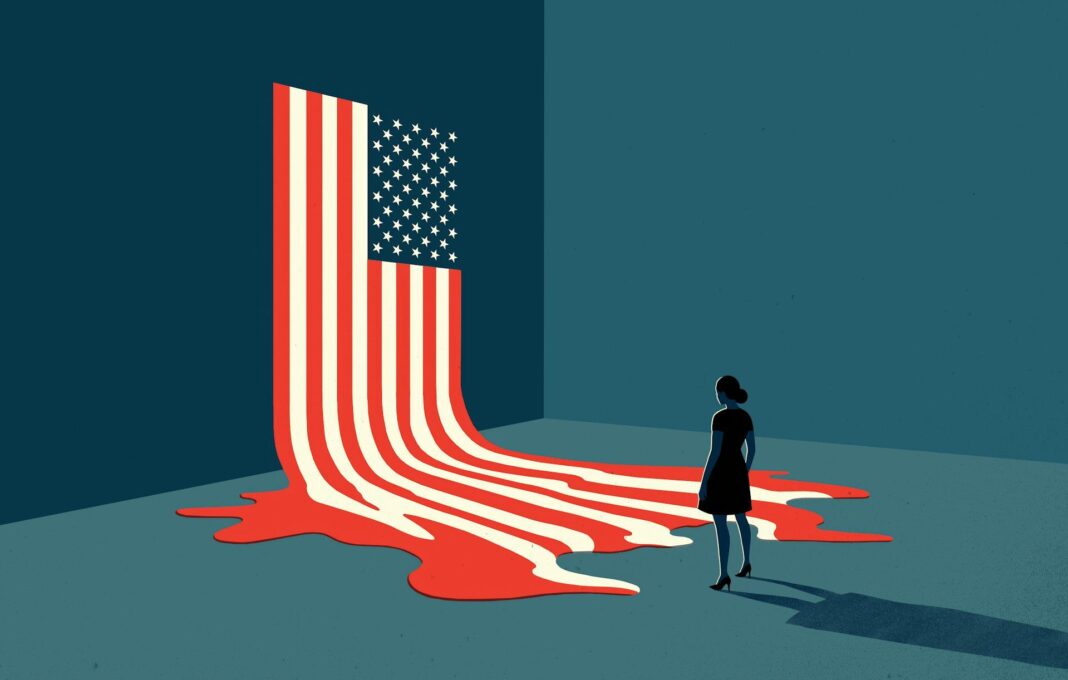For many Americans, Donald Trump’s head-spinning array of executive orders in the early days of his second term look like an unprecedented effort to roll back democracy and the rights and liberties of American citizens.
But it isn’t unprecedented.
As we have written, American history is not a steady march toward greater equality, democracy and individual rights. America’s commitment to these liberal values has competed with an alternative set of illiberal values that hold that full American citizenship should be limited by race, ethnicity, gender and class.
The most famous example of this conflict is the Jim Crow era after Reconstruction, when many of the political and legal rights gained by African Americans in the Civil War era were swept away by disenfranchisement, segregation and discrimination. From roughly 1870 until 1940, democracy and equal rights were retreating, not advancing, leaving what was described in the 1960s by President Lyndon Johnson as “the crippling legacy of bigotry and injustice.”
Today, the Trump administration is seeking to roll back America’s commitment to equality and engaging in a broad effort to limit – if not outright deny – the rights, liberties and benefits of democracy to all Americans.
The biggest gains in African American rights came during the Revolutionary War, the Civil War, World War II and the Cold War, when the United States confronted enemies that Americans believed contradicted its liberal values – the British monarchy, Southern slaveholders, fascist dictators and communist tyrants. The United States highlighted its commitments to democracy and human rights as a way of contrasting itself from its enemies.
But once the pressures of war faded, America’s illiberal values reasserted themselves. With the end of the Revolutionary War and the Civil War, the movement for greater equality stalled and many of the previous gains were rolled back.
The onset of World War II and then the Cold War forced Americans to renew their commitment to democracy and human rights for all Americans. This period is often described as the Second Reconstruction.
Like the First Reconstruction a century earlier, the federal government helped to ensure civil and voting rights for African Americans. These efforts laid the groundwork for advancing the political and civil rights of women, other racial and ethnic groups, immigrants, disabled persons and, eventually, members of the gay and lesbian community.
But like the First Reconstruction, these changes generated intense backlash.
Since the demise of the Cold War over 30 years ago, the Republican Party has increasingly sided with those seeking to roll back the gains of the Second Reconstruction.
Even before Trump first ran for president, the Republican Party began adopting nativist, anti-immigration policies. In 2012, a Republican-dominated Supreme Court gutted a key provision of the Voting Rights Act, the landmark 1965 law barring racial discrimination in voting that was one of the signal achievements of the Second Reconstruction.
In 2016, Trump rose to the Republican nomination by expressing and amplifying the racist and xenophobic views of many white Americans, including the claim that Barack Obama was born outside of the U.S., that Mexican immigrants were criminals and rapists, and that the U.S. should close its borders to anyone from Muslim countries.
Since his second inauguration, Trump has mounted a full-scale effort to undermine the policies of the Second Reconstruction. This effort has been masked as an attack on diversity, equity and inclusion – or DEI – policies. According to Trump and other critics of DEI, these policies are themselves racist, since they allegedly single out white Americans for shame and scorn.
As scholars of race and American politics, we believe that, overall, DEI initiatives have combated racial discrimination and expanded the pools of talented people who can contribute to the nation’s progress.
The Trump administration’s effort to end DEI programs is really an attack on decades of efforts by the federal government to make good on the promise of America: to engage in rigorous nondiscrimination efforts and open up opportunities for all.
One of Trump’s first executive orders, which prominently featured abandonment of DEI policies, also repealed a 60-year-old executive order signed by President Johnson mandating “affirmative action” to end widespread discrimination by the federal government and its contractors.
These diversity initiatives have for more than 50 years included requirements that beneficiaries of these policies must be qualified for the benefits they obtain.
But to Trump and many conservatives, such policies force employers to engage in racial and gender quotas to prove that they don’t discriminate. Furthermore, these efforts to end discrimination, according to Trump’s executive order, “diminish the importance of individual merit, aptitude, hard work, and determination,” leading to “disastrous consequences.”
In other words, Trump and others claim that efforts to end discrimination are themselves a form of discrimination and force the hiring of unqualified and incompetent people.
Trump made this view clear in his comments on the recent collision between a passenger airliner and a military helicopter in Washington, D.C. Before any formal investigation, Trump alleged that the crash resulted from Obama and Biden administration efforts to diversify the Federal Aviation Administration staff. Such efforts, he suggested, elevate unqualified people.
“If they don’t have a great brain … they’re not going to be good at what they do and bad things will happen,” he said.
Efforts to reverse DEI have been accompanied by other antidiversity moves. One example: According to a news release, the Defense Department will no longer use “official resources” to mark “Black History Month, Women’s History Month, Asian American and Pacific Islander Heritage Month, Pride Month, National Hispanic Heritage Month, National Disability Employment Awareness Month, and National American Indian Heritage Month.”
The attack on DEI goes beyond the federal government. Other executive orders mandate that K-12 schools as well as colleges and universities end DEI programs, since they are “anti-American, subversive, harmful, and false ideologies.”
Instead, Trump insists that schools engage only in “patriotic education.”
Such a policy will almost certainly prevent schools from honestly addressing the ways in which racial, ethnic and gender discrimination have influenced America’s past and present.
The Trump administration is attacking the First Reconstruction as well. Another Trump executive order seeks to end birthright citizenship for children of unauthorized alien residents.
That move would limit the 14th Amendment, one of the constitutional cornerstones of the First Reconstruction. Passed in 1868 in order to guarantee citizenship rights for African Americans, it begins by stating:
“All persons born or naturalized in the United States, and subject to the jurisdiction thereof, are citizens of the United States and of the State wherein they reside.”
This provision was included in order to explicitly overturn the notorious 1857 Supreme Court decision, Dred Scott v. Sandford, that ruled that African Americans were not citizens and consequently “they had no rights which the white man was bound to respect.”
How far can the Trump administration go in its efforts to undo the Second Reconstruction?
Numerous legal challenges have already been filed. In the case of the executive order limiting birthright citizenship, a lower federal court judge appointed by President Ronald Reagan blocked the order, calling it “blatantly unconstitutional.”
Many of these cases will ultimately be decided by the Supreme Court, which under Chief Justice John Roberts has been willing to overturn long-established equal rights precedents. Besides its 2012 gutting of the Voting Rights Act, in 2022 the court limited the reproductive rights of women by overturning its 1973 decision, Roe v. Wade. Most recently, in 2023 the court ended a 45-year precedent that allowed colleges and universities to engage in limited forms of affirmative action in order to achieve more student diversity.
Yet despite years of attacks by conservatives and now the Trump administration, most efforts to end discrimination and open doors to all Americans, including DEI, remain popular. And the groups empowered by the Second Reconstruction – racial and ethnic minorities, women, immigrants, the LGBTQ community – are far more numerous and have far more legal and political resources available with which to fight back than those that were aided by the First Reconstruction.
There are now no government pressures driving Americans to make greater progress toward democracy and equal rights for all, as in the relatively brief earlier periods of significant reform in America.
But those reforms have given many more Americans the capacity to push back against policies that violate both American values and American interests.
This article is republished from The Conversation, a nonprofit, independent news organization bringing you facts and trustworthy analysis to help you make sense of our complex world. It was written by: Philip Klinkner, Hamilton College and Rogers M. Smith, University of Pennsylvania
Read more: Trump executive order attacks long-standing American principle of birthright citizenship Civil rights legislation sparked powerful backlash that’s still shaping American politics How Trump could try to stay in power after his second term ends
The authors do not work for, consult, own shares in or receive funding from any company or organization that would benefit from this article, and have disclosed no relevant affiliations beyond their academic appointment.














